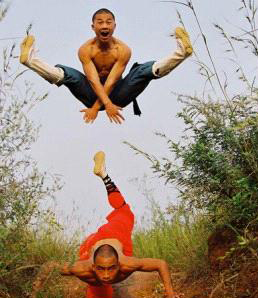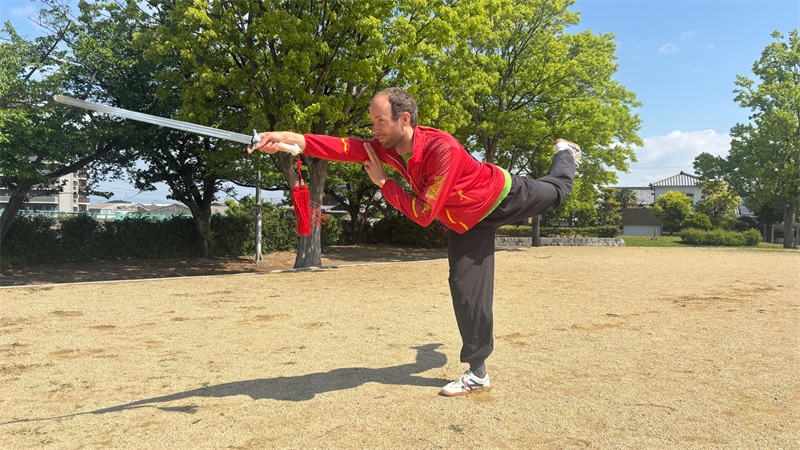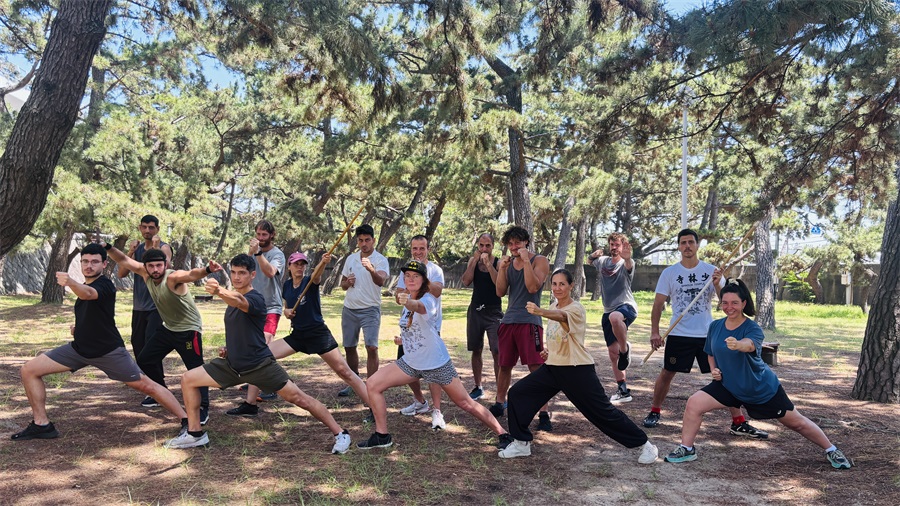
Shaolin Kung Fu
Shaolin kung fu earned its name from the temple where it was first practiced, the Shaolin Temple Monastery. This legendary temple was located in Deng Feng City of the Henan Province in northern China. Many fables and myths have been created over time which have obscured the exact origins of martial arts. The Shaolin Temple was originally built as a Buddhist temple around A.D. 377 during the time of the Six dynasties (A.D. 221 -589). During this warring era, the famous Buddhist monk, venerable Da Mo (Bodhidharma), visited India to preach Buddhism. During his years long stay at the temple, he discovered that the monks in the temple were weak and unable to defend themselves. He understood that a physically healthy body was a requirement for the preparation of spiritual enlightenment and so the venerable Da Mo taught them the “Eighteen Lohan Chuan” to stay fit.

Students practice Shaolin Sword.
By teaching the monks this basic martial art foundation, he not only prepared them for obtaining enlightenment, but also gave them the ability to protect themselves.
Shaolin Martial Arts
Venerable Da Mo went on to further create two Shaolin martial art manuals which were developed from the eighteen lohan chuan. They were called the Yi jin jing and xi sui jing. Yi jin jing is a set of breathing exercises which are to be used for chi training and is the classic document for internal force development. Unfortunately, the original manual for xi sui jing has been lost to history. As a result of Da Mo’s teachings, he was proclaimed as the first patriarch of Shaolin kung fu. Following this was the emergence of the school of Buddhism known as Zen. First proclaimed in the 7th century in China, its teachings emphasized experiential wisdom as a means to attaining enlightenment. Shaolin kung fu was, also, only taught to the monks at the temple originally which led to their fame throughout China for their martial prowess.
Today Shaolin kung fu has many forms, such as: xiao hong chuan, da hong chuan, tong bei chuan and many more. There are several major and important aspects to gong fu. They are internal kung fu, external kung fu, hard kung fu, light kung fu and chi gong, also known as Qigong. Students at our kung fu school in China will learn several important elements of Shaolin kung fu training.

Shaolin Kung Fu groups in 2025 Summer
Shaolin Kung Fu Training
Combination of Practice & Application. After learning how to perform Shaolin Kung Fu patterns correctly, a student must learn how to use them for combat. It is not enough for a student to merely learn the combative functions of Shaolin kung fu patterns. The student must practice the uses many, many times so that they can apply the Shaolin kung fu patterns flawlessly when needed. This can be realized through combination practice. Here, two or more students practice together using various techniques of attack and counters in order to make the students remember the movements and combinations well. The attacks and defense techniques are logically arranged to form a Combination Set.
The practice and application of Shaolin kung fu training are guided by general as well as specific principles. If we understand the underlying principles thoroughly, we can not only perform Shaolin Kung Fu with insight but also achieve better results with less time and effort. Knowing the principles often makes the difference between the novice (no matter how long he may have practiced the art) and the master. Their knowledge of Shaolin Kung Fu principles will enable the master to view with perception and appreciation any form of martial arts he sees, although he may not have learned it before. Most martial arts in the world are influenced in one way or another by Shaolin Kung Fu training and all those different martial arts are found in Shaolin Kung Fu.
Shaolin kung fu requires great finesse and is the most profound martial art in the world. Its depth is not only in its uncountable defense techniques, but more importantly, in its inner meaning-the training of jing qi sheng, Essence, Mind-power and Intrinsic Energy